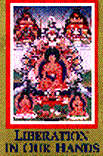
Liberation in Our Hands

Published by The Mahayana Sutra and Tantra Press of Howell, N.J. 908-364-1824.
A Lam Rim teaching given in Tibet in 1921 by  Kyabje Pabongka Rinpoche
Kyabje Pabongka Rinpoche
Transcribed by  Kyabje Trijang Rinpoche.
Kyabje Trijang Rinpoche.
Translated by  Serame Geshe Lobsang Tharchin with Artemus Engle
Serame Geshe Lobsang Tharchin with Artemus Engle
(Please read in order)
IMPERMANENCE IN THE FORM
OF DEATH
(Kyabje Pabongka Rinpoche began the day's discourse by
quoting these lines by the great scholar and spiritual adept Gendun Tenzin
Gyatso: [1]
It (Lam
Rim)[2] is the
essence of the unerring Kangyur and Tengyur[3],
unlike the
false, made-up teachings of others.
It represents the views of the great
philosophers,
unlike the speech of fools.
It contains the realized
experience of learned adepts,
unlike the frenzied delusions of others.
It
is the great road to supreme enlightenment,
unlike the terrifying abyss of
samsara[4].
The
methods of deriving value from a human form possessing leisure and
fortune
1) Recalling death in the sense that we do not remain long in
this life
This section also has three subsections:
(1) The disadvantages of
failing to recall death.
(2) The advantages of recalling
death.
(3) The
actual method of recalling death.
This section has two parts: (1)
meditating on the set of nine points relating to death, and (2) meditating on
the nature of death.
The nine points that make up this instruction
consist of three root categories:
(1) Contemplating the certainty
of death,
(2)
Contemplating the uncertainty of the time of death,
(3) Contemplating that, when we
die, nothing except the dharma can benefit us.
Each of these root
categories is then further explained in terms of three supporting
reasons.
Meditating
on the nature of death.
THE SUFFERING OF THE
LOWER REALMS
Contemplating the Suffering of
Hell Beings The Great Hells
Contemplating the Suffering of
the Adjacent Hells
Contemplating the Suffering of
the Cold Hells
Contemplating the Suffering of
the Partial Hells
Contemplating the Suffering of
the Hungry Ghosts
Contemplating the Suffering of
the Animals and concluding contemplation.
HOME